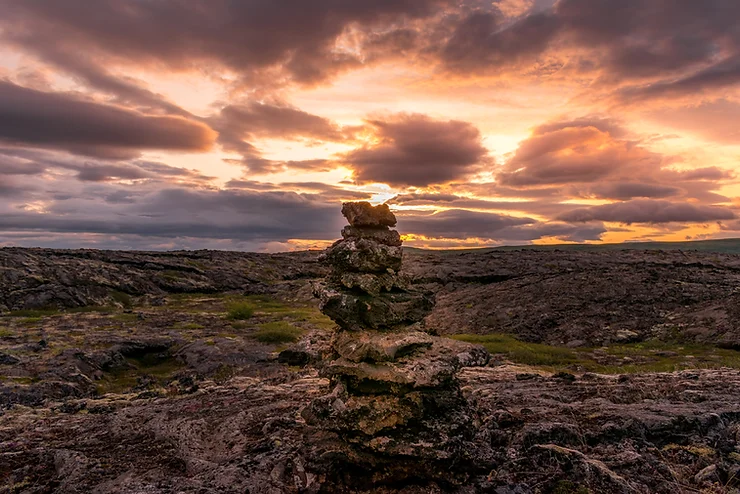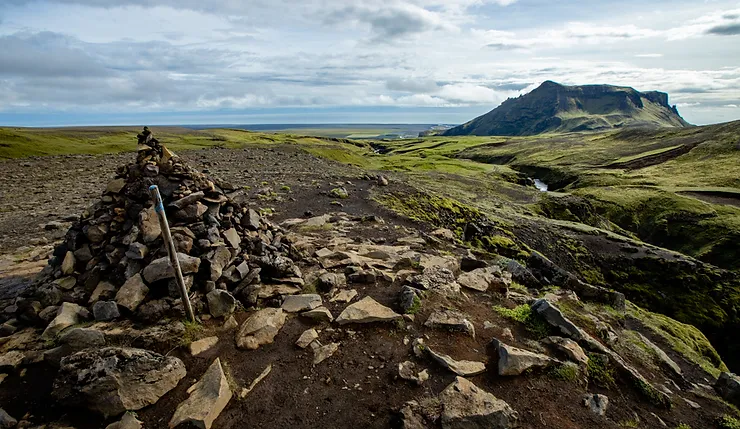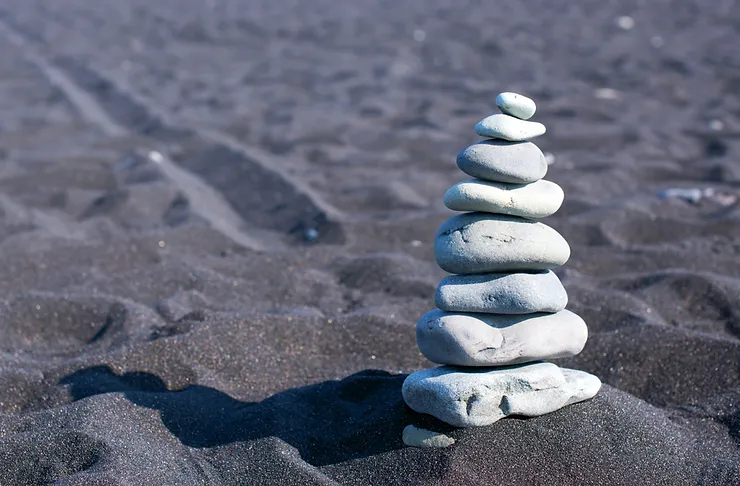Building cairns in Iceland
27-07-2020

If you are a keen hiker anywhere in the world you will probably have come across a cairn or two. You might even have added one of your own rocks to a marker cairn on a hike.
However, there is more than one reason for building these stone piles. Some cairns mark ancient burial mounds while others were built for protection. Some are simply about visitors creating an acknowledgment or sign that they have passed through. Kind of like a graffiti tag on a wall. We humans do like to leave our mark.
When it comes to building cairns in Iceland there is some controversy. The country is very proud of its ancient cairns and the history that they invoke. However, building any new cairns is not welcome. Moving rocks around in the delicate landscape of Iceland can cause considerable damage.
Building a rock pile might seem like a harmless activity but there are various unforeseen consequences. So if you are enjoying a hike in the wonderful landscapes of Iceland please do adhere to the leave no trace philosophy.
What are Cairns rocks?
A cairn is quite simply a pile of rocks assembled by a person or persons. As mentioned the motivation behind creating a rock cairn differs from pile to pile. However, the very earliest cairns were often used by indigenous people in areas with few natural landmarks. These could be on moors or desserts or in the frozen landscapes of the Arctic. Cairns provided an important landmark from which to navigate. They also very likely had symbolic and spiritual meanings.
Cairns for navigation in Iceland
Cairns are most commonly used as trail markers and navigation aids. In Iceland, the earliest cairns date back to the very first settlement of the country in the 9th Century. Can you imagine traversing the mighty landscapes of Iceland on foot with no maps or GPS?
Even if you knew where you were going a route can change dramatically if the Iceland weather blows in. Snowstorms and foggy weather can make hiking and navigating difficult and dangerous.
To help travelers navigate from settlement to settlement the people that came before them created these stone stacks. Cairn marking has likely saved the life of many a beset upon traveler down through the centuries. Seeing the reassuring form of a stone cairn looming out of the fog lets you know that you are safely on the right path. A traveler can carefully skirt around the area from one to the next to find their way.
With this in mind it is obvious why it is so important not to build new random cairns. Pointless cairns could very easily throw people off course and this could even be dangerous. Let's keep hiking in Iceland safe!

Iceland Bone Cairns
As an interesting aside some of the Icelandic cairns are known as bone cairns. These were used as a bit of fun and light relief by Icelandic travelers of the past. The tradition was to place an entertaining message or poem at a cairn for those passing through to find.
To protect the paper from the elements the tradition was to roll the messages inside a sheep bone. The bone was then placed amongst the stones to await discovery. These messages often had a lewd tone to them. Sometimes they were aimed at specific people who were known to be passing through later.
Other reasons for building cairns
As well as being used to mark trails cairns have been built in Iceland for other reasons. Burial cairns are an important part of the history of Iceland. There are several dotted around the country that are said to mark the final resting places of historical figures.
Another reason behind building a cairn is as a kind of talisman for protection. In the remote Westfjords in North Iceland there is a large expanse of three-stone cairns. The area is a treacherous one with a high open cliff. When a traveler passed through they were compelled to build cairns using just three stones. This was both for their own protection and for the safe passage of others.
Another more modern use of cairns was devised by the Settlement Centre in Borgarnes. Here they have created a treasure hunt style experience using tall stack rocks. These cairns mark the scenes of different stories from Iceland’s Sagas. Allowing visitors to discover the stories of the landscape as they walk through it.
Icelandic rangers and cairns
These days the park ranger community in Iceland are actively dismantling and removing new cairns. As well as being potentially dangerous they are considered a blot on the natural landscape. They are looked upon as an unsightly interference in the natural landscape.
Another very important reason for discouraging rock piles is the damage it can do to flora. Plant life in the windswept and weather-beaten landscape of Iceland has a hard enough time taking root. The beautiful vivid green moss that you see creeping over the lava rocks is very slow to grow. So prizing or picking up rocks can leave scars on the delicate mosses that could take many years to heal.
This is not just a problem in Iceland either. In the Acadia National Park in the United States, the park rangers are fighting the same battle. Hikers in the park there have taken to building rock stacks and stone balancer pieces. All of these activities disrupt the natural look of the park landscapes for all. So the official administration there is running a campaign to educate people on the matter.

Leave no trace
So when you're next out exploring Iceland by motorhome hire please do enjoy these historic cairns. But please remember to ‘leave no trace’. Take only photos and leave only footprints (but not in the moss please!). Let’s all keep Iceland safe and beautiful for the next travelers that pass through.